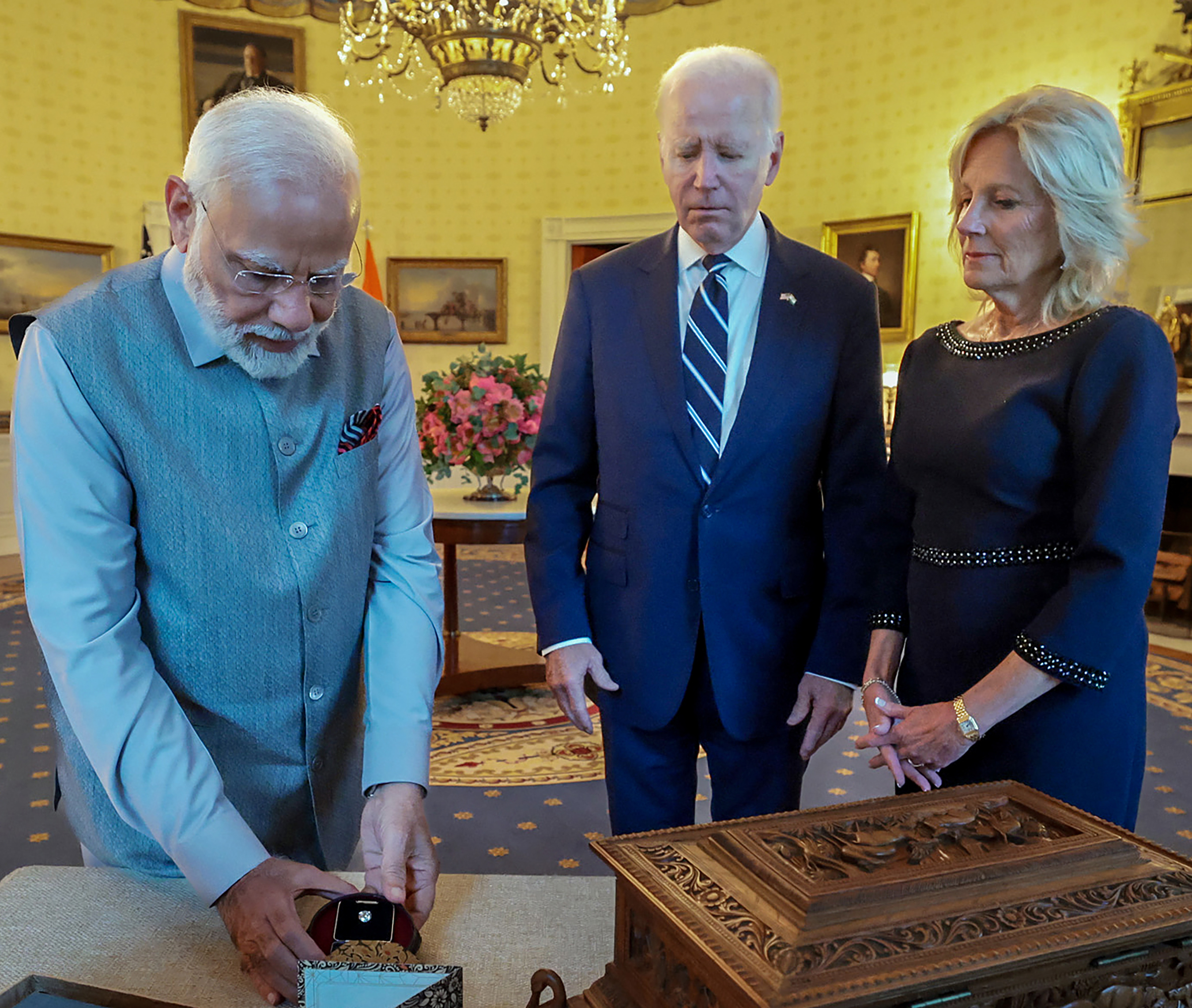
During his visit to the U.S. this week, India’s Prime Minister Narendra Modi presented President Joe Biden and First Lady Jill Biden multiple gifts on Wednesday. But the most interesting among them was a papier mache box containing a 7.5 carat synthetic green diamond.
The lab-grown diamond (LGD) is at the heart of India’s bid to become a global leader in producing the synthetic alternative, which has a much smaller carbon footprint than mined diamonds, and is seen as “conflict free.”
According to India Today, the production of the diamond gifted to the Bidens produced just 0.028 grams of Co2 per carat, which is over 100,000 times less emissions per carat than the production of the average mined diamond.
Below, what to know about India’s quest to become a LGD leader.
More from TIME
What are LGDs, a.k.a. lab-grown diamonds?
Lab-grown diamonds are jewels with the same chemical properties as mined diamonds, containing pure carbon that is crystallized into an isotropic form. In nature, diamonds are created when carbon deposits deep underground—usually 95 to 125 miles below the surface—are subjected to extreme pressure and heat. Scientists believe that it can take over 1 billion years to form a diamond in natural circumstances. However, in laboratory settings, the production process is much faster.
According to Queensmith, a U.K.-based jeweller, there are two ways to create LGDs. The first way, referred to as the chemical vapor deposition (CVD) method, involves the use of a small, already formed diamond. The slice of diamond is placed in a chamber where it is exposed to carbon rich gas and extremely high temperatures. Over the course of several weeks, the carbon gas ionizes and sticks to the original diamond slice. This leads the diamond to grow in size and creates new diamond material.
The second method, known as high pressure high temperature method (HPHT), does not require a pre-existing diamond slice. In this method, pure carbon is pressed through a metal cube and exposed to high electrical heat at the same time. This mimics the settings that carbon deposits in natural environments experience to become diamonds. Because carbon is an abundant resource, this method does not require the intense and dangerous labor that diamond mining requires, which many believe makes lab grown diamonds more ethical and sustainable.
Why is India expanding its LGD program?
From 2018 to 2021, India more than quadrupled the dollar value of its polished synthetic diamond exports, going from $274 million to $1.29 billion in sales.
This year, India’s finance minister Nirmala Sitharaman announced that the government would subsidize research and development costs in the LGD industry by providing a grant to one of the Indian Institutes of Technology for five years.
“Lab-grown diamonds is a technology and innovation sector with high employment potential,” Sitharaman said in her speech. “These are environmentally-friendly diamonds which have optically and chemically the same properties as natural diamonds.”
Currently, India produces 15% of all LGDs in the world, according to India’s Ministry of Commerce and Industry. China is believed to be the leading producer of them around the world, accounting for 50% of the global market share. According to Allied Market Research, the industry was worth $22.3 billion in 2021, and is expected to more than double over the next decade to $55.6 billion.
“The key thing to know about India is that it is already the premier diamond polishing center for both natural and laboratory diamonds. About 90% of all diamonds in the world are polished in India,” says Edahn Golan, a diamond research and data analyst.
According to Golan, this puts India in a good position to move into the LDG space.
“It was kind of a natural evolution that when lab-grown diamonds became more popular, India would be an important center for that as well,” he says.
Why are LGDs important?
Diamonds are used for many purposes, not just jewelry. In fact, 80% of the world’s diamonds are used for industrial purposes. Because diamond is an incredibly sturdy material, it is frequently used in electronics that are designed to last for a long time, like high-end speakers or satellites. Diamonds are also important for dentistry tools, since they are one of the few substances that can easily drill into teeth. The substance is also used in countless other industrial applications that require extremely strong materials.
LGDs are on average cheaper than mined diamonds by 30-40%. They are less likely to rely on dangerous and exploitative labor practices and do not harm the natural habitat in the way mining frequently does.
In the future, lab-grown diamonds are expected to take an increasingly large share of the market and may make diamond jewelry more accessible to the average person.
“There’s a growing interest in lab-grown diamonds and in the long term, I think that what we will see is a bifurcation of the industry that will be on the consumer side,” Golan says. “We’re seeing a trend where the average price of lab-grown diamonds is sinking and it makes it appealing to more consumers.”
While some consumers—especially for jewelry—will likely still prefer mined diamonds because of their scarcity, others will gravitate toward lab-grown diamonds as they become more affordable.
More Must-Reads From TIME
- The 100 Most Influential People of 2024
- Coco Gauff Is Playing for Herself Now
- Scenes From Pro-Palestinian Encampments Across U.S. Universities
- 6 Compliments That Land Every Time
- If You're Dating Right Now , You're Brave: Column
- The AI That Could Heal a Divided Internet
- Fallout Is a Brilliant Model for the Future of Video Game Adaptations
- Want Weekly Recs on What to Watch, Read, and More? Sign Up for Worth Your Time
Contact us at letters@time.com